Key takeaways
- Successful photographers prioritize storytelling and emotional connection over technical perfection, allowing for authenticity in their work.
- Persistence and community engagement play vital roles in a photographer’s growth, encouraging collaboration and shared experiences.
- Researching other photographers through interviews, social media, and workshops provides deeper insights that can inspire personal development.
- Continuous learning and experimentation are essential, as even established photographers strive to evolve their techniques and perspectives.
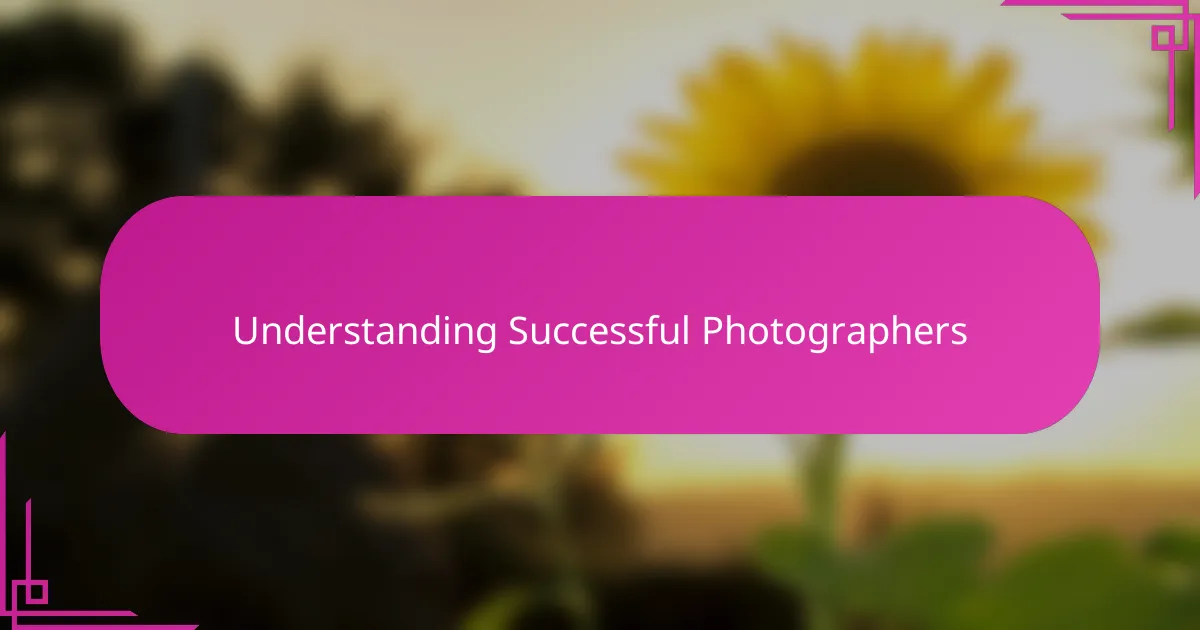
Understanding Successful Photographers
When I started diving into the world of successful photographers, I realized it wasn’t just about having the most expensive gear or the flashiest portfolios. What struck me the most was their mindset—how they approach their craft with patience, curiosity, and a relentless drive to improve. Have you ever wondered what truly sets them apart beyond technical skills?
One thing that really resonated with me was how these photographers embrace failure as a stepping stone. I remember feeling frustrated after my own photoshoots, but seeing how they used setbacks as fuel for growth changed my perspective completely. It made me question if I was too quick to judge my work or if I was willing to push through discomfort like they do.
Understanding successful photographers also means recognizing their unique vision. Each of them tells stories through their images in ways that feel deeply personal and authentic. As I explored their work, I found myself reflecting: how can I develop my own voice while staying inspired by theirs? It’s a delicate balance, but one worth striving for.
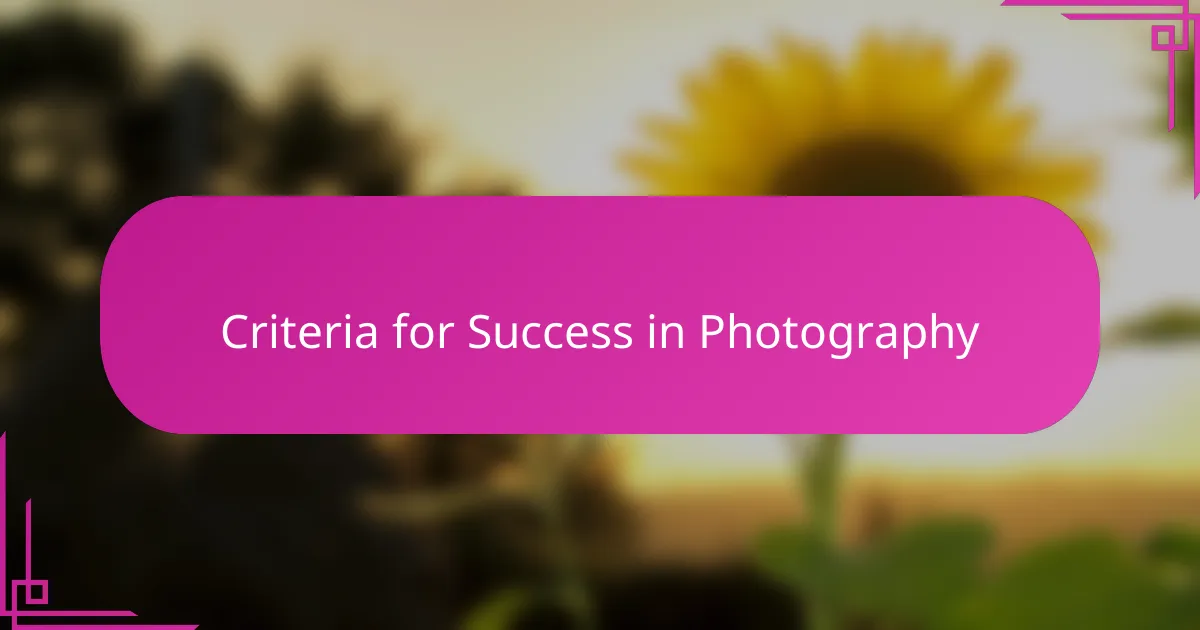
Criteria for Success in Photography
Success in photography, I’ve noticed, isn’t just about mastering the technical side. It’s about consistently capturing emotion and meaning in a way that resonates with others. Have you ever looked at a photo and felt a story unfold without a single word being spoken? That’s the kind of impact successful photographers aim for, and it’s a crucial criterion for their success.
Another piece that stood out to me is the importance of persistence. I used to think being talented enough would carry me through, but observing these photographers made it clear: they work tirelessly, often behind the scenes, honing their skills and pushing boundaries. It made me wonder—how much am I willing to invest before I see real growth in my own work?
Lastly, I realized that building meaningful connections plays a big role. Successful photographers don’t just shoot in isolation; they engage with their audience, clients, and fellow creatives. This networking isn’t about popularity but about growing through shared experiences and feedback. Have you found your photography grows when you open up to community, or do you prefer the quiet solitude of working alone? For me, collaboration has been surprisingly enriching.
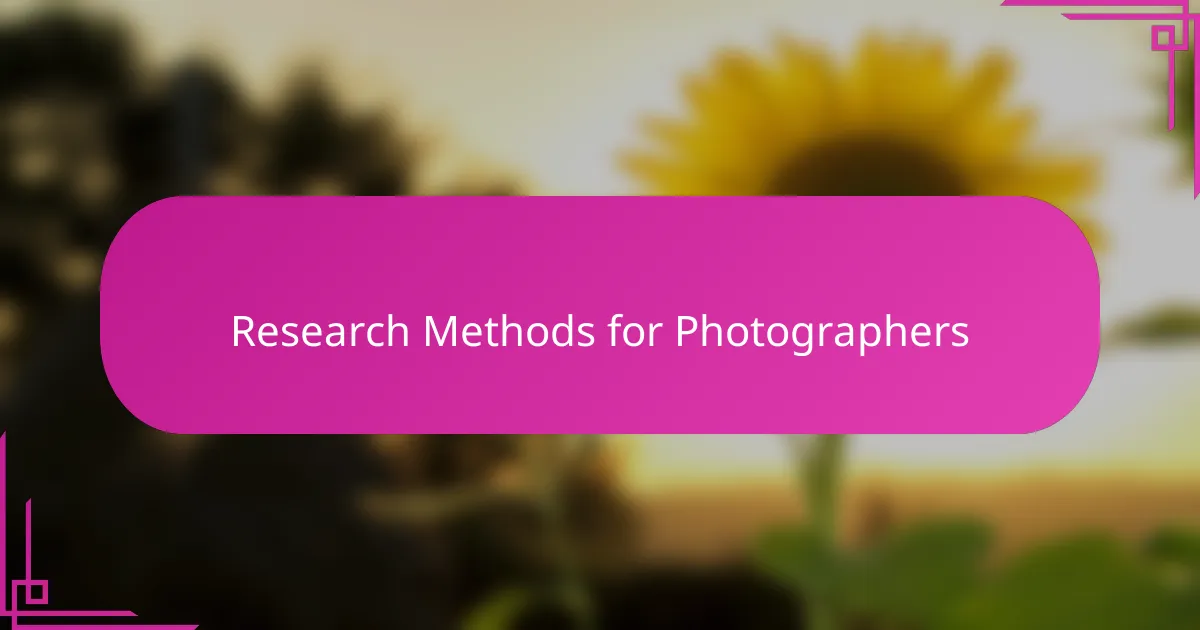
Research Methods for Photographers
When I set out to research successful photographers, I quickly found that gathering information required more than just scrolling through galleries. I made a habit of studying interviews and listening to podcasts where photographers candidly shared their journeys. Have you ever noticed how hearing someone’s story in their own words adds layers of insight that a simple biography just can’t capture?
Another method that really brought clarity was analyzing their social media presence—not just their photos, but how they interact with followers and showcase behind-the-scenes moments. This peek into their day-to-day processes revealed a lot about their work ethic and mindset. It made me think: am I paying enough attention to the story I’m telling around my photos, not just the images themselves?
I also found it invaluable to attend workshops and local exhibitions, even when I felt like an outsider. Engaging face-to-face with photographers and asking questions helped me understand nuances you can’t pick up online. Have you ever learned more from a single conversation than from hours of reading? For me, those real connections transformed my research from a passive task into an active, inspiring exploration.

Tools for Photographer Analysis
One tool that became indispensable for me was analyzing photographers’ portfolios through specialized websites. These platforms allow you to zoom in on their compositions, color grading, and lighting choices. Have you ever caught yourself wondering why certain images evoke such strong emotions? Breaking down these visual elements helped me understand those subtle techniques better.
I also relied heavily on social media analytics tools to dig deeper into how photographers engage their audience. Watching metrics like follower growth and interaction rates gave me clues about what kinds of content resonate most. It made me question: am I merely posting photos, or am I truly connecting with my viewers in a meaningful way?
Lastly, I discovered the power of photo editing software with history tracking features, which lets you see step-by-step adjustments made to images. Peeking behind the curtain of their post-processing workflow was eye-opening and sparked ideas for my own editing style. Have you ever felt stuck editing a photo? Seeing how others approach the same challenge reignited my creativity every time.
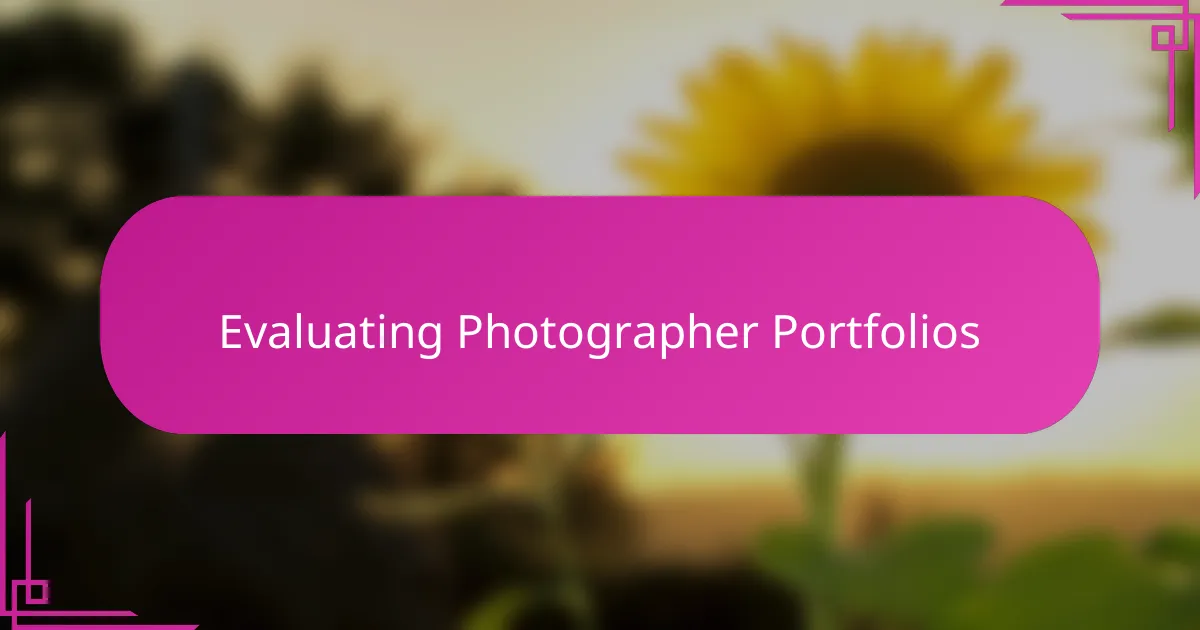
Evaluating Photographer Portfolios
Evaluating photographer portfolios became one of the most insightful parts of my research. I found myself not just looking at the images but trying to feel the story behind each frame. Have you noticed how some portfolios instantly grab your attention while others leave you scrolling without much emotion? That emotional connection is what I came to see as the true test of a great portfolio.
As I went deeper, I realized the importance of consistency. It wasn’t just about a few standout shots; it was the overall style, composition, and mood that repeated across their work. This made me think about my own portfolio—was I showing a clear, cohesive voice or just a random mix of my best photos? That question alone changed how I started editing and selecting images.
I also started paying close attention to the technical details embedded in the portfolios. Lighting, color balance, and sharpness spoke volumes about their skill and artistic choices. Seeing how subtle adjustments could elevate a photo made me more critical but also more inspired to experiment. Have you looked closely enough to catch those tiny elements that make a photo exceptional? For me, that’s where the real learning began.
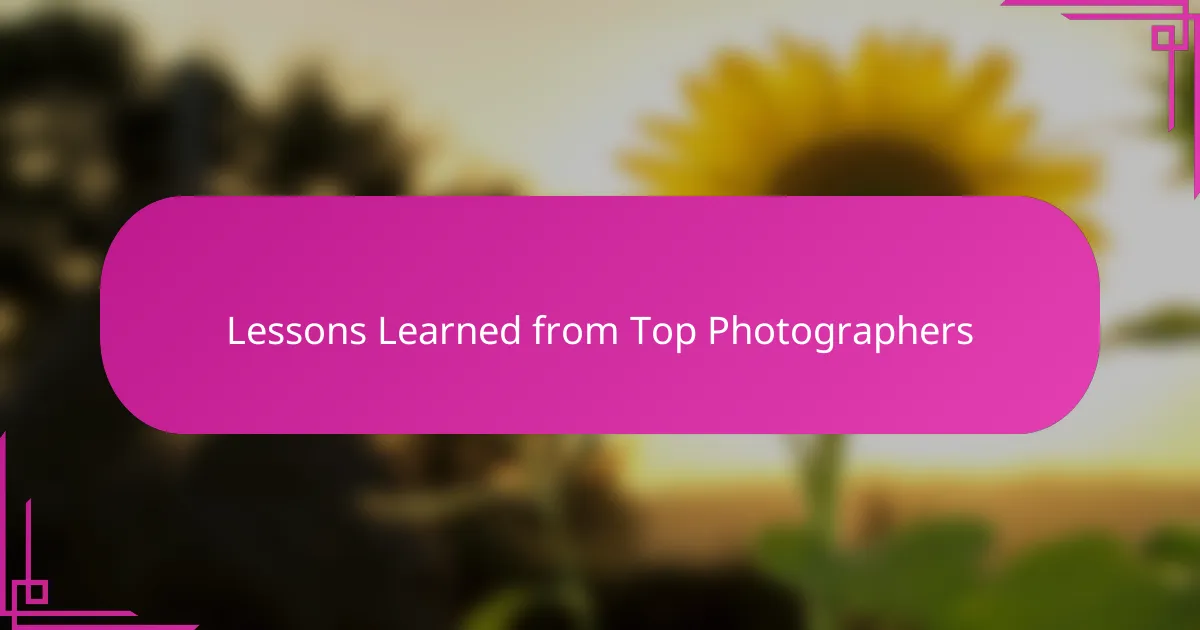
Lessons Learned from Top Photographers
One lesson from top photographers that really hit home for me was the way they prioritize storytelling over perfection. I used to obsess over every technical detail, but watching how they sometimes embrace imperfections to convey emotion made me rethink my approach. Have you ever felt that a slightly imperfect shot can sometimes tell a more powerful story than a flawless but lifeless image?
Another thing I noticed is their incredible patience and willingness to wait for the right moment. It reminded me of a shoot where I grew frustrated waiting hours for the perfect light—yet those few minutes produced my favorite shots. Seeing how top photographers accept that waiting is part of the craft taught me to slow down and trust the process more.
Finally, the importance of continual learning stood out. Even the most established photographers I studied never seem satisfied; they’re always exploring new techniques or perspectives. This inspired me to stay curious and open, asking myself: what can I learn today that will push my work a little further tomorrow? That mindset shift has been a game changer in my own creative journey.
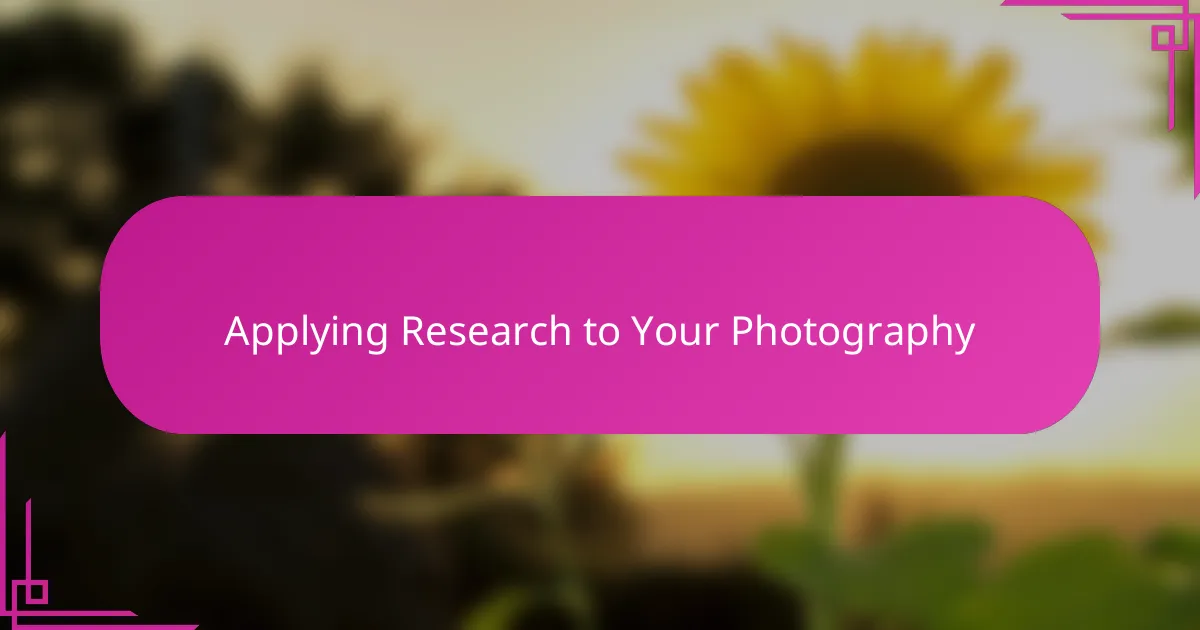
Applying Research to Your Photography
Applying the research I did on successful photographers felt less like copying and more like adapting. I realized that integrating their habits—like embracing patience and seeking unique perspectives—helped me uncover new layers in my own work. Have you ever tried blending your style with what inspires you, only to discover something refreshingly authentic?
I started applying what I learned by setting small, intentional goals for each shoot, focusing not just on technical perfection but on storytelling. This shift made me notice details I used to overlook and pushed me to experiment with lighting and composition in ways I hadn’t dared before. When was the last time a simple change in approach led you to unexpectedly better photos?
Another surprising outcome was how actively sharing my work and process with a community improved my growth. Taking cues from photographers who engaged openly online, I opened up to feedback and collaboration. Rather than feeling vulnerable, I found it motivating—proof that research doesn’t just live in theory; it thrives through practice and connection. Have you experienced that moment when sharing your journey suddenly accelerates your progress?